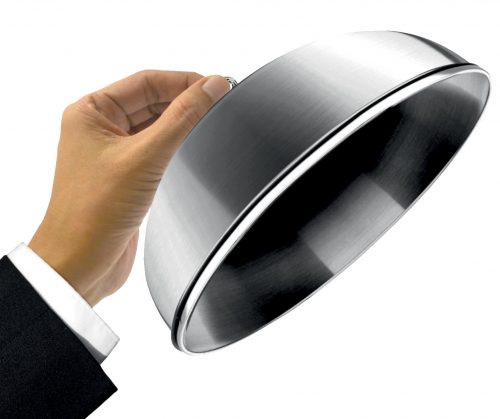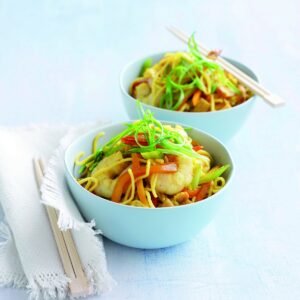
Do you stick to salad and shun carbs at restaurants? Your good intentions could be plating up extra kilojoules, so watch out for these common traps.
Trap #1
You think: I won’t eat all day because I’m going out to dinner
Arriving at a restaurant feeling ravenous is a big mistake. First, you’re likely to over order, and second, you’re likely to quaff your wine and mindlessly pick at bread as you wait. And third, you’ve shunned food all day, so you may feel justified to order dessert, even if you’re full.
Your new restaurant rules!
If you’re dining out, try not to skip lunch. If your reservation is late, take the edge off your appetite with a high-protein afternoon snack that has a low GI (glycaemic index) and will satisfy you for longer, such as a handful of nuts, a piece of fruit or a small tub of reduced-fat yoghurt.
- Skip this: No lunch followed by a hearty dinner of two spring rolls, a bowl of prawn crackers and a large serve of pad Thai.
- Order this: Enjoy a chicken salad sandwich on wholegrain bread and an apple for lunch. At dinner, have two steamed dumplings and a small serve of chilli-basil chicken stir-fry with steamed rice.
- SAVE up to 4000kJ
Trap #2
You think: I’ll steer clear of carbohydrates
Giving up carbs is unhealthy and unnecessary, but do try to stop yourself from tearing into the bread basket as you wait for your meal as you’ll consume a lot more kilojoules.
Your new restaurant rules!
If you like to start with a little bread, try to reduce the amount of carbs in the rest of your meal. Forgo white bread in favour of high-fibre, low-GI carbs, such as kumara, brown rice, wholegrain bread and sourdough bread. Watch portion sizes, too. Aim to fill only a quarter of your plate with carbs, so request small portions or share with your dining companions.
Beware! Bread and butter add unwanted kilojoules before the meal even arrives.
- Skip this: Two mini white dinner rolls spread with butter
- Order this: New (baby) potatoes with your main meal
- SAVE over 800kJ and 8g sat fat
Trap #3
You think: It’s vegetarian, so it must be a healthy option
Vegetarian meals tend to provide less protein so can leave you feeling less than full and often include excessive amounts of fat and starchy carbs. A large plate of pasta swimming in creamy sauce may be vegetarian, but it’s not a balanced meal, and neither is salad drowning in dressing. Unfortunately, many vege dishes also contain lots of cheese, cream or pastry, serving up even more fat — especially saturated fat — and kilojoules.
Your new restaurant rules!
Look for dishes with legumes, such as lentils or chickpeas, as these satisfy with protein and fill you up with fibre. Many restaurants offer pasta as their vegetarian options, so order those with tomato or vegetable-based sauces. Risotto can be a healthy meal but if it’s based on butter or cream, consider another dish. Minestrone and soups made with lentils (or other legumes) are low kilojoule yet filling, especially if they come with wholegrain bread. Craving pizza? Request less mozzarella and more veges.
- Skip this: Pumpkin and cheese ravioli in a creamy sauce
- Order this: Lentil and vege burger with a leafy garden salad
- SAVE 1000kJ or more and 10g+ sat fat
Trap #4
You think: Salad is a better choice than steak
Salad is a great way to boost your intake of fibre and nutrient-rich vegetables, but don’t be fooled by its ‘health halo’. In a 2011 US study, health-conscious diners were more likely to order a ‘salad’ than they were to choose the same dish described as pasta.
Look past the name and focus on the ingredients. If there’s cheese, bacon, pancetta, croutons or an oily or creamy dressing, the dish is likely to be full of fat and kilojoules. With olives, anchovies or parmesan, you’ll get a big dose of salt too! Finally, if the word drizzled appears, chances are the dish will be drowning in oil.
Your new restaurant rules!
Garden, bean and Greek salads can be ordered as sides or modified to make more balanced main meals. If you’re ordering a low-protein green salad, ask the waiter for extras such as grilled chicken, prawns or a boiled egg to add flavour and satisfaction, or add heart-healthy fats, such as nuts, seeds and avocado. And there’s no point in choosing healthy salad greens only to ruin them with lots of dressing. Forgo creamy options in favour of olive oil, vinegar and citrus-based varieties, and ask for them on the side for more portion control.
- Skip this: Caesar salad with bacon, croutons, parmesan and creamy Caesar dressing
- Order this: A garden salad with grilled chicken dressed with an olive oil and balsamic vinaigrette
- SAVE 1000kJ or more and 8g+ sat fat
Trap #5
You think: Asian food is always light
Many Asian sauces, such as fish, oyster and soy, are very high in salt while sweet-and-sour, honey-soy and sweet-chilli sauces can be full of sugar.
Sushi has a reputation for being light, but when deep-fried foods and mayonnaise creep into sushi fillings and toppings, the kilojoule count climbs dramatically. A bowl of laksa is usually made from coconut milk or cream, both of which are fatty and energy dense. One serve can deliver half your daily kilojoules and exceed your daily sodium limit.
Asian food can also contain a lot of refined white carbohydrates — think doughy dumplings and white rice.
Remember, we want carbs to make up just one quarter of our meals; another quarter is satisfying protein and the remaining half, nutritious fibre-rich veges.
Your new restaurant rules!
Stick to salmon and avocado rolls and bite-size nigiri that are free of fancy toppings, or order Vietnamese rice-paper rolls, usually full of veges. Vietnamese salads are also full of healthy ginger, lime, lemongrass and coriander. When you feel like a stir-fry, opt for a small amount of steamed rice or noodles (avoiding the fried variety) and fill the rest of your plate with lean meat or tofu and lots of veges. Poached fish is also a healthy choice, especially if you ask for sauce on the side.
To order a healthier Asian soup, opt for clear flavour-rich varieties, such as Vietnamese pho or Thai tom yum, over creamy blends.
- Skip this: Chicken laksa
- Order this: Thai beef salad
- SAVE up to 2500kJ and 14g sat fat
Five questions to ask your waiter
The smallest change can make a big difference to your health, so don’t be shy about making these simple requests.
- May I have a smaller portion? If the main meals look big, see whether you can order an entrée-size portion as a main course.
- Sauce on the side, please? This gives you portion control.
- Could we have some side plates so we can share? You get to try a bit of everything and it’s great for desserts.
- May we have a carafe of tap water? Keep your water glass full. You’ll drink less wine and limit the empty kilojoules.
- Can I take the rest of my meal home? Resist the urge to clean your plate and turn dinner into tomorrow’s lunch!
Vege pasta isn’t light if it’s swimming in creamy sauce!
Beware! Bread and butter add unwanted kilojoules before the meal even arrives.
Article sources and references
- Irmak C et al. 2011. The impact of product name on dieters’ and nondieters’ food evaluations and consumption. Journal of Consumer Research 38:390–405https://miami.pure.elsevier.com/en/publications/the-impact-of-product-name-on-dieters-and-nondieters-food-evaluat
www.healthyfood.com










